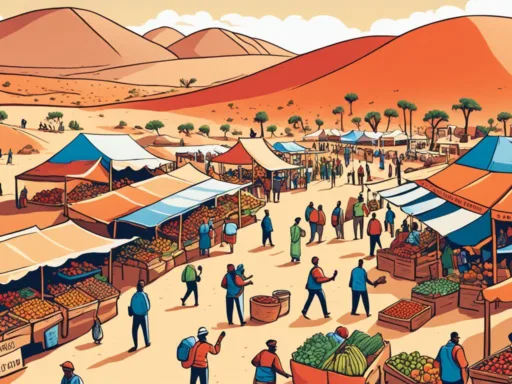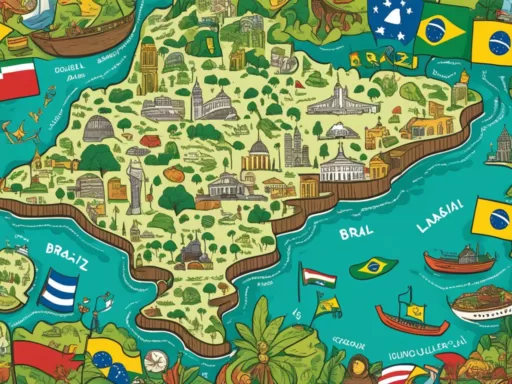The diverse cultural heritage of Ethiopia is mirrored in its languages, with the nation being home to a stunning array of over 80 indigenous tongues. This linguistic wealth showcases the intricate complexity of Ethiopian societies, where languages serve not only as a means of communication but also as bearers of cultural identity and history. Within this array, there are languages spoken Ethiopia-wide that tie groups stretching across vast landscapes together, fostering a sense of unity amid diversity.
The Ethiopian linguistic landscape is dominated by languages belonging to the Afroasiatic language family, particularly the Cushitic and Semitic branches, which offer a fascinating look at the interconnectedness of languages and cultures. Among these, key Ethiopian languages like Amharic, Oromo, Somali, and Tigrinya are spoken prevalently, each upholding its distinct influence across regional and national plains. Such rich variety makes the study of Ethiopian languages both a linguistic and anthropological journey.
Key Takeaways
- Ethiopia features an impressive assortment of languages, with more than 80 indigenous dialects enriching its cultural canvas.
- The major Ethiopian languages, including Amharic, Oromo, Somali, and Tigrinya, tie together a significant portion of the country’s inhabitants.
- Afroasiatic languages, particularly from the Cushitic and Semitic branches, play a leading role in the daily discourse of Ethiopians.
- Ethiopia’s history of maintaining its sovereignty has allowed for the flourishing of Ethiopian languages without the overlay of a colonial tongue.
- The presence of regional languages highlights the localized identities within Ethiopia’s broader society.
- Foreign languages such as English and Arabic contribute to Ethiopia’s linguistic diversity, driven by education and religious practices.
- The nation’s commitment to preserving its linguistic heritage is evident in its education policies and language use in governance.
The Diversity of Languages Spoken in Ethiopia

Ethiopia is a mosaic of cultures, a fact that is perhaps nowhere more apparent than in its impressive linguistic diversity. With over 80 unique languages classified into several language families—including Afroasiatic, Nilo-Saharan, Omotic, and Cushitic—each region of Ethiopia offers a different linguistic community with its own tapestry of speech, customs, and traditions.
Rapid policy changes have embraced the educational use of native tongues, thereby promoting the revival and sustainability of Ethiopia’s regional languages. This support of linguistic heritage not only secures the continuous transmission of cultural knowledge but also enhances the national discourse, celebrating the country’s multicultural identity.
- Ethiopia’s language landscape includes languages from the Afroasiatic, Nilo-Saharan, Omotic, and Cushitic families.
- Policy shifts are reinforcing the use of indigenous languages in schools.
- Each language is a custodian of an ethnic group’s heritage and identity.
- International languages, including English and Arabic, have found a significant place in Ethiopian society.
While indigenous tongues dominate the cultural and social spheres, the prevalence of languages like English and Arabic underscores Ethiopia’s broader connections to global networks and religious communities. This juxtaposition of local and international languages fosters a unique communicative environment where local identities are affirmed and global interactions are enriched. In the context of linguistic diversity in Ethiopia, it is clear that every language plays a pivotal role—be it in preserving historical narratives, binding communities, or bridging Ethiopia to the wider world.
Linguistic Composition: From Afroasiatic to Nilo-Saharan
The vibrant symphony of languages in Ethiopia is a testament to its storied past and diverse cultural landscape. Dominating this linguistic stage are the Afroasiatic languages, an extensive family of tongues that have shaped communication throughout the country. Amidst these, the Cushitic and Semitic branches feature prominently, contributing to the colorful cultural tapestry that defines Ethiopia.

Afroasiatic Languages Predominance
In Ethiopia, the Afroasiatic languages take center stage, with key languages like the Amharic language and the Oromo language leading in terms of the number of speakers. The Amharic language, Ethiopia’s official lingua franca, boasts more than 31.8 million native speakers, while the Oromo language, with its deep cultural roots, is spoken by over 36 million people. Furthermore, the Somali language and the Tigrinya language enrich the linguistic diversity of the nation, each holding its distinct place within the Ethiopian social fabric.
The Cushitic and Omotic Branches
The Cushitic languages Ethiopia is known for include an array of languages such as Sidama, Afar, and Hadiyya. These languages not only serve functional communication purposes but also preserve the rich oral traditions unique to each ethnic group. The Omotic languages Ethiopia harbors, while smaller in number, are nonetheless critical to the cultural mosaic of the nation. Despite the ongoing debates around their classification, these languages are an indispensable part of Ethiopia’s linguistic heritage.
Nilo-Saharan Languages Presence
Adding another layer to this intricate linguistic mix are the Nilo-Saharan languages Ethiopia. While these languages do not boast as large a number of speakers as their Afroasiatic counterparts, they represent the historical and cultural complexities of Ethiopia’s northwest regions. Their role in the country’s linguistic diversity further underlines Ethiopia’s status as a crucible of ancient languages and evolving dialects.
| Language Family | Languages | Number of Speakers | Writing System |
|---|---|---|---|
| Afroasiatic | Amharic | 31.8 million | Ge’ez script |
| Afroasiatic | Oromo | Over 36 million | Latin script |
| Afroasiatic | Somali | 6.72 million | Latin script |
| Afroasiatic | Tigrinya | 6.39 million | Ge’ez script |
| Cushitic | Sidama | 4.34 million | Latin script |
| Omotic | Various dialects | Varied | Latin script |
| Nilo-Saharan | Various languages | Smaller communities | Varied |
Languages Spoken Ethiopia: Official and Working Languages
In its stride toward a richly diverse national identity, Ethiopia has embraced multiple official languages, bolstering the nation’s commitment to its cultural plurality. The Ethiopian government has proclaimed that Afar, Amharic, Oromo, Somali, and Tigrinya are the official federal working languages. This crucial step towards inclusivity allows each ethnic majority within the various regions and chartered cities the autonomy to conduct administrative and educational activities in their native tongues.

Among these official languages Ethiopia honors, Amharic, with its deep historical roots and broad use in legal, trade, and day-to-day communication, holds a place of distinction. Its role in the nation extends back to the late 12th century and continues to the present day, reaching beyond just governance and into the social fabric of Ethiopian life.
Even with this strong orientation towards local languages, foreign languages have also found a significant place in Ethiopia’s linguistic environment. English, acknowledged as the most widely spoken foreign language, serves a pivotal function. It is the medium of instruction in secondary and tertiary education, and it facilitates federal communication, underscoring its essential role in the working languages Ethiopia engages with on a global scale.
- Afar: A recognized working language in the Afar Region.
- Amharic: The historical working language with a widespread usage extending to courts and commerce.
- Oromo: The primary language of the Oromia Region and immensely influential in terms of native speakers.
- Somali: Officially used in the Somali Region, reflecting the unique linguistic landscape.
- Tigrinya: Not only serves the Tigray Region but also a portion of the population in Eritrea.
The cornerstone of Ethiopia’s multilingual approach lies in its commitment to recognizing and fostering the importance of each language. By bolstering the use of multiple official and working languages Ethiopia not only strengthens the sense of unity within its diverse ethnic landscape but also enfranchises its people to participate in governance and education in meaningful ways.
The Cultural and Historical Impact of the Amharic Language
The Amharic language resonates deeply within Ethiopian heritage. Its influence extends from the historical courts of royalty to the vibrant realms of music and literature, carrying the intangible spirit of a nation’s legacy. The intricate weave of language and culture in Ethiopia is notably captured through the enduring presence of Amharic, standing as a testament to the enduring Amharic cultural impact on Ethiopian society.
Amharic’s Integration in Ethiopian Heritage
Amharic’s storied past is embedded in the rich tapestry of Ethiopian culture. Once the language of the administrative and religious elite, it has long been at the crux of Ethiopian governance and spiritual life. From ancient religious scripts to the lyrics of songs that pulse with the heart of the nation, Amharic has been a central vehicle conveying Ethiopia’s art, wisdom, and identity. The language embodies the essence of Ethiopian unity, having been employed as a bridge between diverse ethnic communities and as a medium for nationalistic expression.
The Use of the Ge’ez Script in Amharic
The Ge’ez script is an emblem of antiquity and scholarship, serving as more than just a writing system—it is a symbol of Ethiopian continuity and resilience. In Amharic’s form and function lies the Ge’ez script, a distinct abugida whose characters have chronicled Ethiopian narratives for centuries. As the foundational script of the Ethiopian Orthodox Church’s liturgy, the Ge’ez script maintains a sacred status, carrying the weight of religious and cultural ceremonies with each stroke and syllable.

The Amharic language, manifested through the elegant scrawls of the Ge’ez script, is a vessel for the collective memory and cultural wealth of Ethiopia. The heritage it encapsulates and the traditions it propels forward affirm its position as not just a tool of communication but as the living embodiment of Ethiopian identity. Through the continued use of the Amharic script in both sacred texts and secular literature, Ethiopia honors the profound intertwining of language with its historical roots and its evolving culture, ensuring the language’s vitality for generations to come.
Oromo and Other Widely Spoken National Languages
The linguistic landscape of Ethiopia is punctuated by a number of widely spoken languages that not only serve functional purposes but also symbolize the vast cultural expanse of the country. Among these, the Oromo language holds a place of particular significance due to its vast number of native speakers, while other languages like Tigrinya and Somali are pivotal to the cultural identities of their respective regions.
The Oromo Language and Its Significance
As the most populous language by native speakers in Ethiopia, the Oromo language is a cornerstone of the nation’s cultural heritage. Proclaimed for its Oromo language significance, it represents a unifying factor for the Oromo people, encompassing a legacy of resilience, history, and cultural pride. Its switch to a Latin-based script has opened doors to broader accessibility, paving the way for enhanced educational opportunities and preservation of cultural narratives.
Regional Languages: Tigrinya, Somali, and More
Beyond the Oromo language, Ethiopia’s linguistic diversity includes other major languages that hold significant roles within their communities. The Tigrinya and Somali languages, for instance, are integral to the Cushitic and Semitic branches of the Afroasiatic language family. Essential to understanding the regional dialects Ethiopia cherishes, these languages echo the diverse voices of Ethiopia’s regional narratives.
The Tigrinya language, primarily spoken in the Tigray region, anchors the community with a strong sense of identity and history. Similarly, the Somali language is not merely a means of communication for the Somali people but a vehicle for cultural endurance within the Somali Region of Ethiopia. Together, these languages enhance the nation’s rich tapestry of Cushitic languages and dialects, attesting to an enduring linguistic and cultural diversity that Ethiopia is committed to maintaining.

| Language | Speakers in Ethiopia | Significance to Culture | Writing System |
|---|---|---|---|
| Oromo | Over 36 million | National identity, educational advancement | Latin script |
| Tigrinya | 6.39 million | Cultural identity, regional heritage | Ge’ez script |
| Somali | 6.72 million | Cultural preservation, regional communication | Latin script |
The future vibrancy of Ethiopia’s intricate language spectrum relies heavily on the country’s dedication to nurturing each linguistic community, thereby honoring the voices and stories that emerge through these diverse means of expression.
Conclusion
Embarking on the final leg of our journey through the expansive linguistic landscape of Ethiopia, we’ve uncovered not only the complexity and beauty of its many tongues but also the commitment to nurturing an incredible Ethiopian linguistic heritage. The harmonious blend of over 80 indigenous languages with the echoes of foreign tongues gives us a vibrant picture of multilingualism in Ethiopia, a country where each language carries the weight of history and the promise of the future. Language preservation in Ethiopia stands as a beacon of cultural identity, respecting the threads of tradition that weave through the nation’s narrative.
Preserving Ethiopia’s Linguistic Heritage
In the face of globalization’s relentless march, Ethiopia’s dedication to protecting its linguistic diversity shines through. Progressive policies have played a vital role in empowering various ethnic groups to maintain and develop their native languages, demonstrating a steadfast commitment to ensuring the survival and prospering of Ethiopia’s communicative legacy. By prizing language preservation, Ethiopia safeguards the stories, wisdom, and identity embedded within its myriad of voices, ensuring that its rich cultural fabric remains intact for generations to come.
The Future of Multilingualism in Ethiopia
As Ethiopia strides into the future, it carries the mantle of multilingualism with a keen sense of balance. The increasing prevalence of English, especially in educational institutions, points to a deliberate move towards global integration. Yet, even as English emerges as a tool for international dialogue, internal policies remain firmly rooted in the idea that the multiplicity of indigenous languages is the cornerstone of Ethiopia’s multicultural identity. These policies not only speak to the country’s recognition of the importance of its linguistic tapestry but also its resolve to cultivate a future where being multilingual is celebrated and preserved. In doing so, they paint a hopeful portrait of what the languages future in Ethiopia might look like—a symphony of voices, each telling its own story, yet contributing to the harmony of the whole.
FAQ
What Languages are Spoken in Ethiopia?
Ethiopia is home to a diverse array of languages, with over 80 languages spoken across the country. These include Amharic, Oromo, Somali, Tigrinya, Sidama, Wolaytta, Gurage, Afar, and Hadiyya among many others. The country also has a significant presence of English and Arabic, often used in education and in religious contexts.
Can you describe the linguistic diversity in Ethiopia?
Ethiopia’s linguistic diversity is extensive, reflecting its complex cultural fabric. There are languages from various families, including the Afroasiatic, Cushitic, Nilo-Saharan, and Omotic language families. This diversity is further enriched by the multitude of regional dialects present within each language group, adding to the country’s rich tapestry of spoken languages.
Which language family has the most speakers in Ethiopia?
The Afroasiatic language family has the most speakers in Ethiopia. Notable languages from this family include Amharic, Oromo, Somali, and Tigrinya, which are spoken by a majority of the Ethiopian population.
Are there official languages in Ethiopia?
Yes, Ethiopia has multiple working languages at the federal level, including Amharic, Afar, Oromo, Somali, and Tigrinya. Additionally, regions within Ethiopia are allowed to designate their own official languages for regional governance and education.
How has the Amharic language influenced Ethiopian culture?
Amharic has had a profound influence on Ethiopian culture. Historically used in royal courts and religious texts, it also serves as a symbol of national unity. It’s a key medium for the nation’s literary, poetic, and musical expressions, and is used daily for communication, business, and administration.
What script is used to write the Amharic language?
The Ge’ez script, which dates back several centuries, is used to write the Amharic language. This script is unique to Ethiopia and has played a central role in the religious and cultural history of the nation, particularly within the Ethiopian Orthodox Church.
What is the significance of the Oromo language in Ethiopia?
The Oromo language holds significant cultural and social importance in Ethiopia as it is the most widely spoken language by native speakers in the country. It reflects the identity and heritage of the Oromo people and has been empowered by adopting a Latin-based script for wider accessibility and educational use.
Do regional languages play a significant role in Ethiopia?
Absolutely! Regional languages such as Tigrinya and Somali are integral to their respective communities. They are crucial in maintaining the cultural identity and social fabric of these regions, and they are recognized officiating languages in their own areas.
What efforts are being made to preserve Ethiopia’s linguistic heritage?
Ethiopia is actively working on the preservation and promotion of its linguistic diversity. There are policies in place that support education in native languages and efforts to document and revitalize many indigenous languages. These measures contribute to the conservation of the country’s rich linguistic heritage.
How is Ethiopia balancing its multilingual heritage with the need to integrate into the global community?
Ethiopia is promoting multilingualism by encouraging the use of indigenous languages while also recognizing the importance of international languages like English, which is prevalent in education and is essential for global communication. This approach aims to maintain the country’s multicultural identity while engaging with the broader international community.






